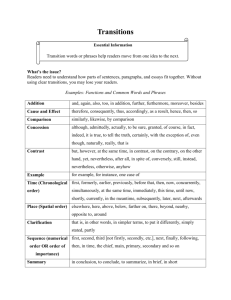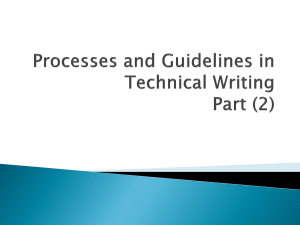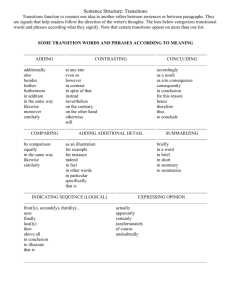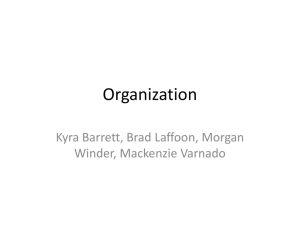The Portable Editor Tips for Improving Your Writing Transitions
advertisement
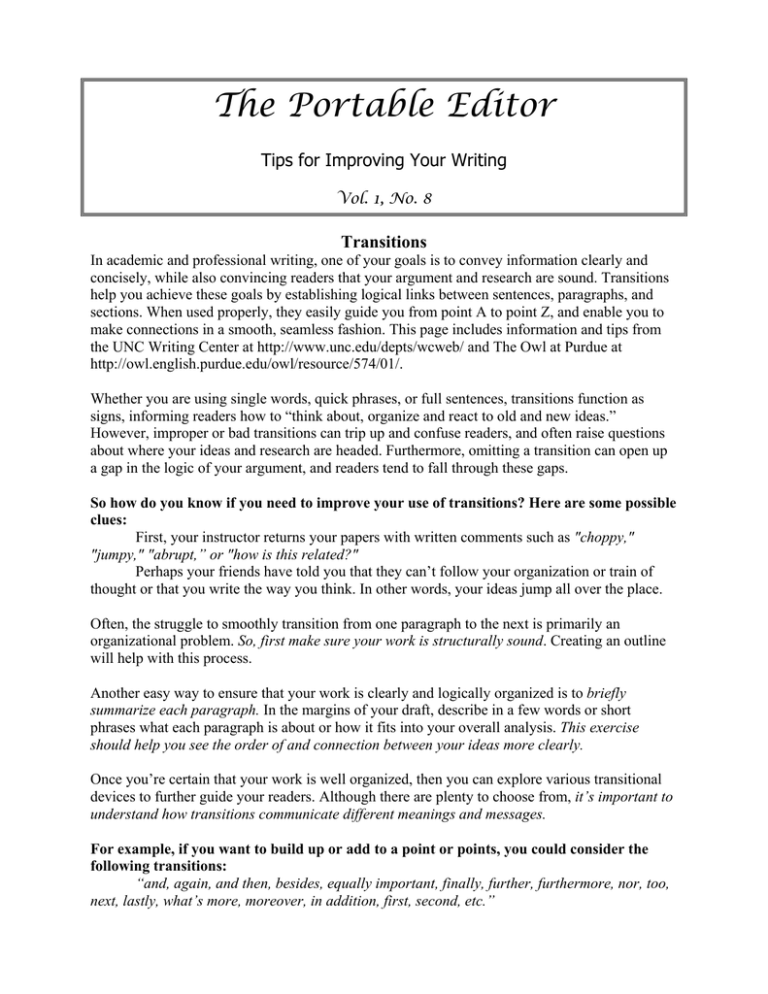
The Portable Editor Tips for Improving Your Writing Vol. 1, No. 8 Transitions In academic and professional writing, one of your goals is to convey information clearly and concisely, while also convincing readers that your argument and research are sound. Transitions help you achieve these goals by establishing logical links between sentences, paragraphs, and sections. When used properly, they easily guide you from point A to point Z, and enable you to make connections in a smooth, seamless fashion. This page includes information and tips from the UNC Writing Center at http://www.unc.edu/depts/wcweb/ and The Owl at Purdue at http://owl.english.purdue.edu/owl/resource/574/01/. Whether you are using single words, quick phrases, or full sentences, transitions function as signs, informing readers how to “think about, organize and react to old and new ideas.” However, improper or bad transitions can trip up and confuse readers, and often raise questions about where your ideas and research are headed. Furthermore, omitting a transition can open up a gap in the logic of your argument, and readers tend to fall through these gaps. So how do you know if you need to improve your use of transitions? Here are some possible clues: First, your instructor returns your papers with written comments such as "choppy," "jumpy," "abrupt,” or "how is this related?" Perhaps your friends have told you that they can’t follow your organization or train of thought or that you write the way you think. In other words, your ideas jump all over the place. Often, the struggle to smoothly transition from one paragraph to the next is primarily an organizational problem. So, first make sure your work is structurally sound. Creating an outline will help with this process. Another easy way to ensure that your work is clearly and logically organized is to briefly summarize each paragraph. In the margins of your draft, describe in a few words or short phrases what each paragraph is about or how it fits into your overall analysis. This exercise should help you see the order of and connection between your ideas more clearly. Once you’re certain that your work is well organized, then you can explore various transitional devices to further guide your readers. Although there are plenty to choose from, it’s important to understand how transitions communicate different meanings and messages. For example, if you want to build up or add to a point or points, you could consider the following transitions: “and, again, and then, besides, equally important, finally, further, furthermore, nor, too, next, lastly, what’s more, moreover, in addition, first, second, etc.” Or perhaps, you want to make a comparison, then you could consider: “whereas, but, yet, however, nevertheless on the contrary, by comparison, where, compared to, compared with, up against, balanced against, vis a vis, but, although, conversely, meanwhile, after all, in contrast, although this may be true.” These transitions can assist with emphasis: “definitely, extremely, obviously, in fact, indeed, in any case, absolutely, positively, naturally, surprisingly, always, forever, perennially, eternally, never, emphatically, unquestionably, without a doubt, certainly, undeniably, without reservation.” The groupings above are just a sample of the transitional devices you can use. But a word of caution: uninformative placeholders do not a transition make!! The phrases below do nothing more than overload your sentences with clutter so avoid, avoid, avoid: • The fact that • As a matter of fact • It is significant that • It should be pointed out • It is interesting to note • The presence of • In the course of • It is noteworthy Interested in Individual Writing Help? Drop‐in Writing Support Tuesdays, Noon–2 p.m. Office 548E One‐on‐One Writing Support Please e‐mail or call to schedule an appointment Diane Wyant–dwyant@email.unc.edu Office 548E, 842‐5575 Tuesdays: 3 p.m.–6 p.m.; Thursdays 1 p.m.–6 p.m. Susan White–sewhite@email.unc.edu Office 302C, 962‐6418 Mondays: Noon–2 p.m.; Tuesdays: 5 p.m.–6:30 p.m.; Fridays: Noon–2 p.m. These hours are reserved for students, but other times may be available.
